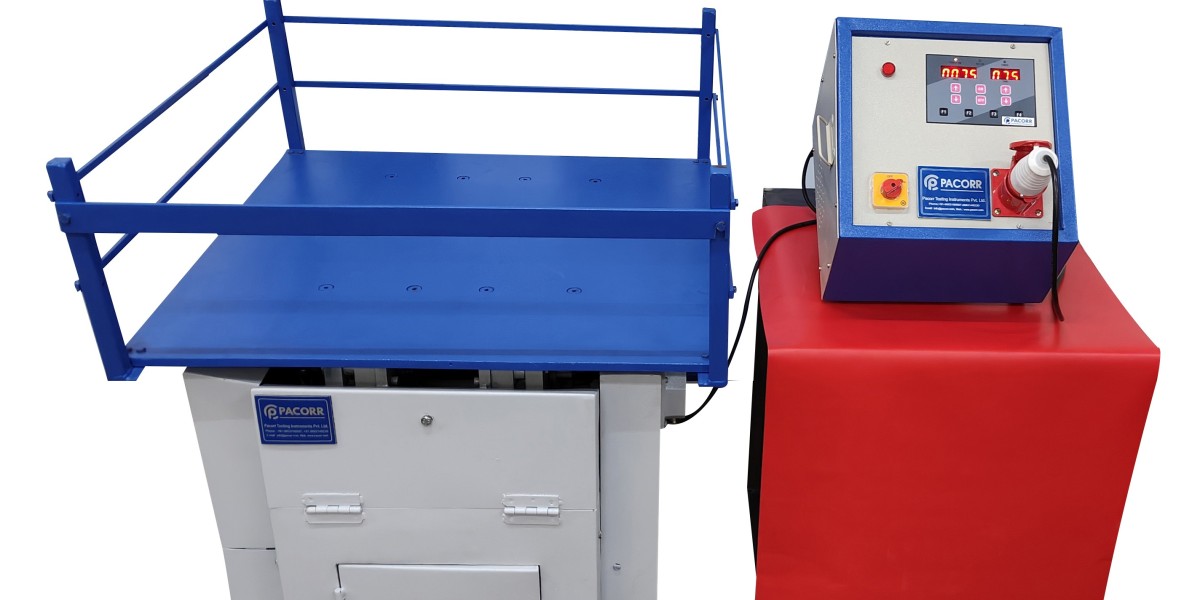Introduction
In the realm of product testing, ensuring the resilience and reliability of materials against vibrations and shocks is critical. The Vibration Table is an essential instrument designed to simulate the vibrations and shocks that products may encounter during transportation and usage. This article explores the features, applications, and benefits of the Vibration Table, emphasizing its importance in maintaining product quality and durability.
What is a Vibration Table?
A Vibration Table, also known as a vibration test table or shaker table, is a device used to subject products and materials to controlled vibrations. By replicating the conditions products might face in the real world, this testing equipment helps manufacturers identify potential weaknesses and improve the robustness of their designs. The Vibration Table is widely used in industries such as automotive, aerospace, electronics, and packaging to ensure products meet stringent quality standards.
Key Components of a Vibration Table
- Table Platform: The surface on which the test specimen is placed. It is designed to withstand various load capacities.
- Vibration Generator: The mechanism that produces vibrations. It can be an electromagnetic shaker, hydraulic shaker, or mechanical exciter.
- Control System: Allows precise control of vibration frequency, amplitude, and duration. Advanced systems include programmable controllers for complex testing scenarios.
- Data Acquisition System: Collects and analyzes data from the tests, providing insights into the material's behavior under vibrational stress.
- Isolation System: Minimizes external vibrations to ensure accurate test results.
Applications of the Vibration Table
The Vibration Table is versatile and finds applications across various industries:
- Automotive: Testing components such as engines, exhaust systems, and electronic modules for vibration resistance.
- Aerospace: Ensuring the durability of aircraft parts and systems under vibrational stresses.
- Electronics: Evaluating the resilience of electronic devices, circuit boards, and connectors.
- Packaging: Assessing the ability of packaging materials to protect contents during transportation.
- Construction: Testing building materials and components for structural integrity under vibrational forces.
Benefits of Using a Vibration Table
- Improved Product Durability: Helps identify and rectify weaknesses in products, enhancing their overall durability.
- Quality Assurance: Ensures that products meet industry standards and regulations, leading to higher customer satisfaction.
- Cost Savings: Reduces the risk of product failures, returns, and recalls, saving costs associated with repairs and replacements.
- Enhanced Safety: Ensures that products, especially those used in critical applications like automotive and aerospace, are safe and reliable.
- Informed Design Decisions: Provides valuable data that aids in designing more robust and vibration-resistant products.
How to Operate a Vibration Table
Operating a Vibration Table involves several key steps to ensure accurate and reliable results:
- Specimen Preparation: Secure the test specimen on the table platform according to test requirements.
- Setup: Configure the vibration parameters, including frequency, amplitude, and duration, based on the testing standards.
- Testing: Initiate the vibration test and monitor the specimen's response.
- Data Analysis: Collect and analyze the data to assess the material's performance under vibrational stress.
Maintenance and Calibration
Regular maintenance and calibration of the Vibration Table are essential to ensure its accuracy and longevity. This includes:
- Routine Inspections: Regularly inspect the table for any signs of wear or damage.
- Calibration: Periodically calibrate the device to maintain its precision and accuracy.
- Cleaning: Keep the table and its components clean to ensure smooth operation.
Conclusion
The Vibration Table is an indispensable tool for manufacturers aiming to produce high-quality, durable products. By accurately simulating real-world vibrational conditions, it enables thorough testing and validation of materials and components. Investing in a Vibration Table ensures that products can withstand the rigors of transportation and usage, leading to enhanced reliability and customer satisfaction.
For more information about the Vibration Table and other testing equipment, visit paccor.com. The website offers comprehensive resources and expert support to help you find the perfect testing solutions for your needs.
FAQ: Vibration Table
- What is a Vibration Table?
Answer: A Vibration Table, also known as a vibration test table or shaker table, is a device used to subject products and materials to controlled vibrations. It simulates the vibrations and shocks that products may encounter during transportation and usage, helping to identify potential weaknesses and improve product durability.
- Why is vibration testing important?
Answer: Vibration testing is crucial for ensuring the resilience and reliability of products. It helps manufacturers identify and address potential weaknesses, ensuring that products can withstand real-world conditions. This leads to improved product quality, enhanced safety, and reduced risk of failures.
- What industries use Vibration Tables?
Answer: Vibration Tables are used across various industries, including automotive, aerospace, electronics, packaging, and construction. They are essential for testing components and materials that are subject to vibrational stresses in their applications.
- How does a Vibration Table work?
Answer: A Vibration Table works by generating controlled vibrations through a vibration generator. The test specimen is placed on the table platform, and the control system sets the desired vibration parameters. The data acquisition system collects and analyzes the test data to assess the material's performance under vibrational stress.
- What are the key components of a Vibration Table?
Answer: The key components include the table platform, vibration generator (such as an electromagnetic shaker or hydraulic shaker), control system, data acquisition system, and isolation system. These components work together to ensure accurate and reliable vibration testing.
- What types of tests can be performed with a Vibration Table?
Answer: Vibration Tables can perform a variety of tests, including sinusoidal vibration testing, random vibration testing, shock testing, and resonance search and dwell testing. These tests help assess the durability and reliability of products under different vibrational conditions.
- How do I prepare a specimen for vibration testing?
Answer: Specimen preparation involves securing the test specimen on the table platform according to the test requirements. It is essential to follow the specified standards and guidelines to ensure accurate and reliable test results.
- What should I consider when selecting vibration parameters?
Answer: When selecting vibration parameters, consider the product's expected real-world conditions, including the frequency, amplitude, and duration of vibrations it will encounter. The control system should be set to replicate these conditions accurately.
- How is the data from vibration testing analyzed?
Answer: The data acquisition system collects the test data, which is then analyzed to determine the material's performance under vibrational stress. The analysis provides insights into the material's durability, identifying any weaknesses or areas for improvement.
- How often should the Vibration Table be calibrated?
Answer: Regular calibration is essential to maintain the accuracy and precision of the Vibration Table. The frequency of calibration depends on the usage and manufacturer's recommendations, but it is generally advisable to calibrate the device periodically.
- What maintenance is required for the Vibration Table?
Answer: Routine maintenance includes regular inspections for wear or damage, cleaning the table and its components, and ensuring all parts are in good working condition. Proper maintenance ensures the longevity and reliability of the Vibration Table.
- Can the Vibration Table be used for quality control in manufacturing?
Answer: Yes, the Vibration Table is an essential tool for quality control in manufacturing. It helps ensure that products meet industry standards and can withstand vibrational stresses during transportation and usage, leading to higher product quality and customer satisfaction.
- Where can I learn more about Vibration Tables?
Answer: For more detailed information about Vibration Tables and other testing equipment, visit paccor.com. The website offers comprehensive resources and expert support to help you find the perfect testing solutions for your needs.
If you have any additional questions or need further assistance, please feel free to contact our support team through the website.
About Vibration Tables
Introduction
Vibration Tables, also known as vibration test tables or shaker tables, are essential tools used in various industries to simulate the vibrational stresses that products might encounter during transportation and usage. These tables help manufacturers identify potential weaknesses in their products, ensuring durability and reliability. This article provides an in-depth look at Vibration Tables, their components, functionalities, applications, and the benefits they offer.
What is a Vibration Table?
A Vibration Table testing device designed to apply controlled vibrations to a product or material to simulate the conditions it may face in the real world. By subjecting products to these vibrations, manufacturers can evaluate their performance, identify weaknesses, and improve their designs to withstand actual operating conditions. Vibration Tables are widely used in industries such as automotive, aerospace, electronics, packaging, and construction.
Key Components of a Vibration Table
- Table Platform: The surface where the test specimen is placed. It must be robust enough to handle various load capacities and vibrational forces.
- Vibration Generator: The mechanism that produces vibrations. This can be an electromagnetic shaker, hydraulic shaker, or mechanical exciter, depending on the application and required vibration profile.
- Control System: Allows precise control of vibration parameters such as frequency, amplitude, and duration. Advanced systems feature programmable controllers for complex testing scenarios.
- Data Acquisition System: Collects and analyzes the data from the tests, providing insights into the material's behavior under vibrational stress.
- Isolation System: Minimizes external vibrations to ensure that the test results are accurate and not influenced by external factors.
Applications of Vibration Tables
Vibration Tables are versatile and used across various industries for multiple purposes:
- Automotive Industry: Testing components such as engines, exhaust systems, and electronic modules to ensure they can withstand vibrations encountered during vehicle operation.
- Aerospace Industry: Ensuring the durability and reliability of aircraft parts and systems under vibrational stresses experienced during flight.
- Electronics Industry: Evaluating the resilience of electronic devices, circuit boards, and connectors to vibrations.
- Packaging Industry: Assessing the ability of packaging materials to protect contents during transportation and handling.
- Construction Industry: Testing building materials and components for structural integrity under vibrational forces.
Benefits of Using Vibration Tables
- Improved Product Durability: Helps in identifying and rectifying weaknesses in products, enhancing their overall durability.
- Quality Assurance: Ensures that products meet industry standards and regulations, leading to higher customer satisfaction.
- Cost Savings: Reduces the risk of product failures, returns, and recalls, saving costs associated with repairs and replacements.
- Enhanced Safety: Ensures that products, especially those used in critical applications like automotive and aerospace, are safe and reliable.
- Informed Design Decisions: Provides valuable data that aids in designing more robust and vibration-resistant products.
How to Operate a Vibration Table
Operating a Vibration Table involves several key steps to ensure accurate and reliable results:
- Specimen Preparation: Secure the test specimen on the table platform according to test requirements.
- Setup: Configure the vibration parameters, including frequency, amplitude, and duration, based on the testing standards.
- Testing: Initiate the vibration test and monitor the specimen's response.
- Data Analysis: Collect and analyze the data to assess the material's performance under vibrational stress.
Maintenance and Calibration
Regular maintenance and calibration of the Vibration Table are crucial to ensure its accuracy and longevity. This includes:
- Routine Inspections: Regularly inspect the table for any signs of wear or damage.
- Calibration: Periodically calibrate the device to maintain its precision and accuracy.
- Cleaning: Keep the table and its components clean to ensure smooth operation.
Conclusion
The Vibration Table is an indispensable tool for manufacturers aiming to produce high-quality, durable products. By accurately simulating real-world vibrational conditions, it enables thorough testing and validation of materials and components. Investing in a Vibration Table ensures that products can withstand the rigors of transportation and usage, leading to enhanced reliability and customer satisfaction.
For more information about Vibration Tables and other testing equipment, visit paccor.com. The website offers comprehensive resources and expert support to help you find the perfect testing solutions for your needs.










